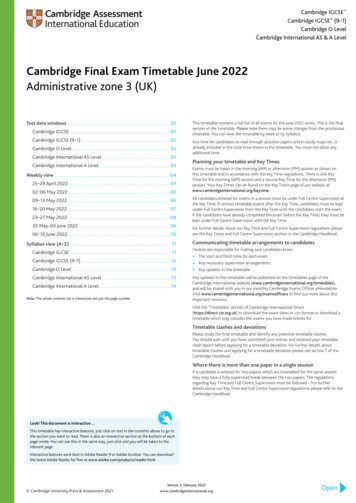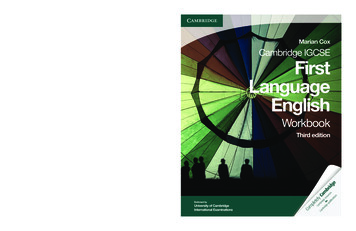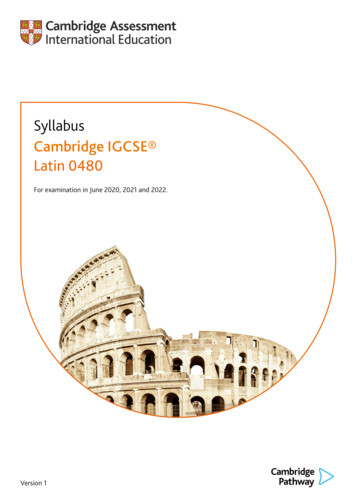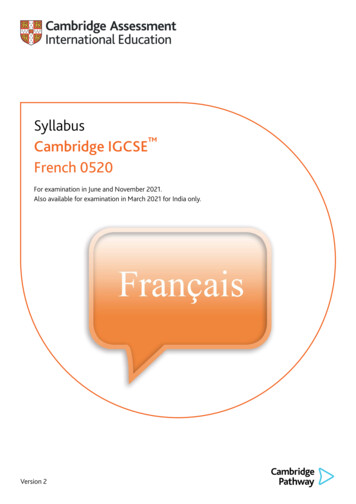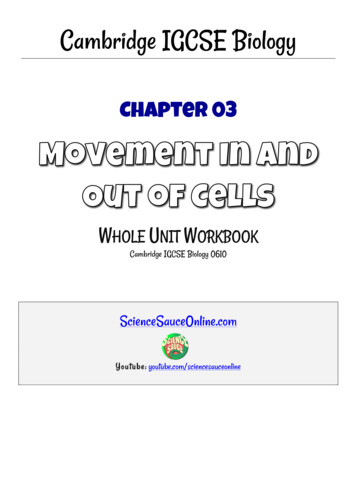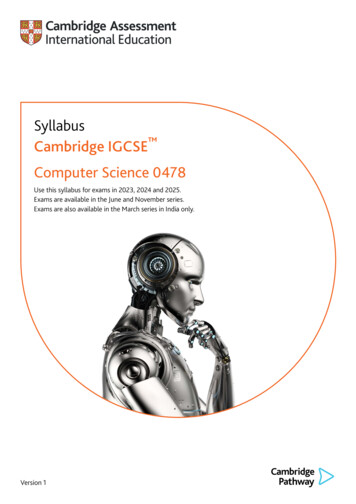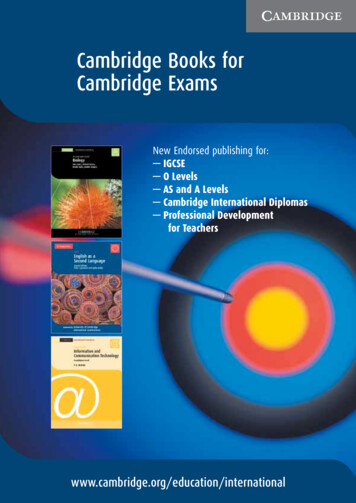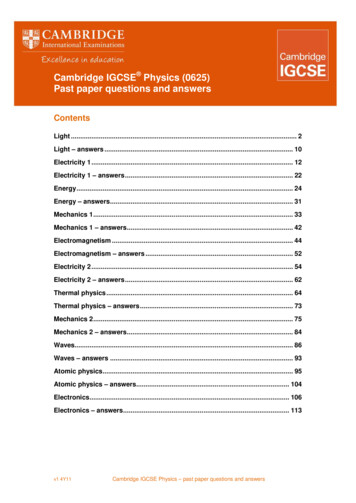
Transcription
1Cambridge IGCSE Physics (0625)Past paper questions and answersContentsLight . 2Light – answers . 10Electricity 1 . 12Electricity 1 – answers . 22Energy . 24Energy – answers . 31Mechanics 1 . 33Mechanics 1 – answers . 42Electromagnetism . 44Electromagnetism – answers . 52Electricity 2 . 54Electricity 2 – answers . 62Thermal physics . 64Thermal physics – answers . 73Mechanics 2 . 75Mechanics 2 – answers . 84Waves. 86Waves – answers . 93Atomic physics. 95Atomic physics – answers. 104Electronics . 106Electronics – answers. 113v1 4Y11Cambridge IGCSE Physics – past paper questions and answers
2LightCORE questionsCore 1At night, the light beam from a torch is shone into a swimming pool along the line TSA.Instead of striking the bottom of the pool at A, the beam travels to B, as shown on Fig. 1.Fig. 1(a) At S, the direction of the beam changes. State the name we use to describe this change.[1](b)(i)On Fig. 1, draw the normal to the surface at S.(ii)Clearly mark and label the angle of incidence.v1 4Y11Cambridge IGCSE Physics – past paper questions and answers[2]
3(c) Fig. 2 shows the same pool and the same points A, B, S and T. The critical angle for thewater is 50 .Fig. 2(i)A beam of light is directed up from B to S. On Fig. 2, carefully draw the path of theray from B to S and then out into the air.(ii)1.A beam of light is directed upward from A to S. Describe what happens to thebeam at S.2.Explain why this happens.[4]v1 4Y11Cambridge IGCSE Physics – past paper questions and answers
4Core 2(a) A ray of red light passes through a glass prism, as shown in Fig. 3.Fig. 3What name do we use for the change of direction of the ray as it enters the glass?.[1](b) Fig. 4 shows the same prism, with white light passing through it.The path of red light is shown.Fig. 4(i)On Fig. 4, draw a possible path for blue light.(ii)Something else is happening to the white light, in addition to what is shown in Fig. 3.What name do we use for this?.[5](c) Light from the Sun is now passed through the prism. The path of red light is shown inFig. 5Fig. 5We can detect infra-red rays using a thermocouple. On Fig. 5, mark with the letter T aposition where the thermocouple could detect the infra-red rays after they have passedthrough the prism.[1]v1 4Y11Cambridge IGCSE Physics – past paper questions and answers
5Core 3Fig. 6 shows a view from above of a vertical mirror. A small lamp is placed at the pointmarked L.Fig. 6(a) One ray, LP, from the lamp has been drawn.(i)At P, draw and label the normal to the mirror.(ii)At P, draw and label the reflected ray.(iii)Mark, using an X for each, two angles which are equal.(b) Carefully mark, using a clear dot, the position of the image of the lamp.[3][1](c) If you were looking into the mirror from point L, you might see something like Fig. 7“looking back at you”. (Apologies if you are better looking than this!)Fig. 7(i)Mark clearly with the letter R, the image of your right ear.(ii)Your nose is 30 cm from the mirror.How far from your nose is its image? .[2]v1 4Y11Cambridge IGCSE Physics – past paper questions and answers
6ALTERNATIVE TO PRACTICAL questionsAlternative to Practical 1Fig. 8 represents the apparatus an IGCSE class is using for an optics experiment, in which aglass beaker filled with water acts like a lens.The glass beaker filled with water is placed with C, the centre of its base, on a line labelledLL’. An optics pin is placed at the point labelled O, so that the pin is touching the side of thebeaker.Two points A and A’ are on the surface of the beaker at equal distances from the line LL’. Thepin at point O acts as an optical object. The ray emerging from A is located by using two pinsplaced at two points labelled P1 and P2.(a) Draw a neat, thin and accurate line to show the path of the ray from O to A in the water.[3]Complete the path, in air, of the emerging ray along AP1P2.(b) Produce the line P2P1A backwards so as to cut the line LL’. Label, with the letter I, thepoint where the two lines cross. Point I is the position of the image of the pin O when it istouching the side of the beaker.[2](c) Draw the line OA’ to represent a ray in water from O passing through A’. Using theinformation you gained in (b), draw a line to show the path of the ray in air after is passesthrough the point A’. Mark your diagram in such a way as to show how you found thedirection of the ray in air.[1](d) Take measurements to calculate the following ratio.IR : OC . : 1Record your measurements and show your working.v1 4Y11Cambridge IGCSE Physics – past paper questions and answers
7Alternative to Practical 1Fig. 8v1 4Y11Cambridge IGCSE Physics – past paper questions and answers
8EXTENSION questionsExtension 1Fig. 9 shows an object placed 2.0 cm from a thin lens, which is to be used as a magnifyingglass.The focal length of the lens in 3.0 cm. The diagram is drawn to full scale.Fig. 9(a) On Fig. 9, draw any two rays from the tip of the object which enable you to locate the tipof the image. Draw in the image and label it I.[3](b) On Fig. 9, draw in an eye position which would enable image I to be seen.[1](c) By taking measurements from Fig. 9, work out how many times bigger the image is thanthe object.The image is . times bigger than the object.v1 4Y11Cambridge IGCSE Physics – past paper questions and answers[2]
9Extension 2Fig. 10 shows how a right-angled prism may be used to change the direction of a ray of light.Fig. 10(a) Explain why the ray of light does not change direction at D and at F.[1](b) State one property of the light which does change at D and at F. At each point saywhether it increases or decreases.[2](c) At E the light splits, with one ray along the surface of the prism and one ray along EF.Draw the normal at E. Label the critical angle with the letter X and state its value.critical angle .[2](d) The refractive index of this glass may be calculated using the formularefractive index of glass 1 / sin c,where c is the critical angle.Use your value of the critical angle of this glass to calculate its refractive index.refractive index .[2]v1 4Y11Cambridge IGCSE Physics – past paper questions and answers
10Light – answersCore 1(a) refraction(b)(c)(i)the normal should be drawn at right angles to the surface of the water at S(ii)the angle of incidence should be shown between the normal and the incident ray(i)the beam should be reflected away from the normal along ST(ii) 1 total internal reflection2the angle in the water is greater than the critical angleCore 2(a) refraction or deviation(b)(i) the blue path should show 2 downward refractions (i.e. below the path for red), oneat each face(ii) dispersion(c) T should be shown just above the emergent red rayCore 3(a)(i) the normal should be shown at right angles to the mirror at P(ii) the reflected ray should be shown at the same angle to the normal as the incidentray by eye(ii) either angles i and r or the angles between the rays and the mirror(b) the dot should be shown on the reflected ray as far from the mirror as L is(c)(i) the ear on the right should be identified(ii) 60 cmv1 4Y11Cambridge IGCSE Physics – past paper questions and answers
11Alternative to Practical 1(a) three marks are gained bya neat thin line OAa neat, thin line AP1P2an arrow from O(b) two marks are gained bya neat line extended to LL’labelled I(c) the line should be a continuation of IA’(d) IR /OC should lie between 2.9 and 3.1 or to scale of diagram reproducedExtension 1(a) two of thesethrough either focusthrough centre of curvatureray produced back to form an image(b) the eye should be in a sensible position to the left of the lens(c) the image length should be 4.5 0.2, approximately 3 times bigger than the object oraccording to the scale of the diagramExtension 2(a) the ray hits at right angles to the surfaceor angle I 0 it travels along the normal(b) the velocity / speed / wavelengthincreases at Fdecreases at D(c) the value 45 should be stated or shown on the diagram(d) the refractive index 1 / sin 45 v1 4Y11Cambridge IGCSE Physics – past paper questions and answers
12Electricity 1CORE questionsCore 1A laboratory technician wants to make a resistor of value 64 Ω, using some resistance wire.He takes 1.0 m of this wire. The wire is shown in Fig. 1 as AC. He connects up the circuitshown.Fig. 1(a) He connects the crocodile clip at B, which is 0.5 m from A.Here are the readings he gets.voltmeter reading12 Vammeter reading1.5 ACalculate the resistance of wire AB.ANSWER: resistance of AB .Ω [3](b) The laboratory technician now connects the crocodile clip to C, to measure theresistance of 1 m of the wire. The wire has constant thickness.(i)v1 4Y11In the spaces below, write the readings he obtains. Ignore the effects of theresistance of the ammeter, voltmeter and battery.voltmeter reading . Vammeter reading . ACambridge IGCSE Physics – past paper questions and answers
13(ii)What is the resistance of wire AC?ANSWER: resistance of AC . Ω [3](c) Use your answer to (b) to answer the following questions.(i)What is the resistance per metre of this wire?ANSWER: resistance per metre . Ω / m(ii)What length of wire does the laboratory technician need for the 64 Ω resistor?ANSWER: length needed . m [3]v1 4Y11Cambridge IGCSE Physics – past paper questions and answers
14Core 2(a) On Fig 2, sketch the graph you would expect to get if you plotted values of the potentialdifference V across a metallic conductor at constant temperature and the current Ithrough it.[2]Fig. 2(b) How would you use the graph to find the resistance of the conductor?.[1]v1 4Y11Cambridge IGCSE Physics – past paper questions and answers
15ALTERNATIVE TO PRACTICAL questionsAlternative to Practical 1Fig. 3 shows the top of a variable resistor that has a scale of resistance, which gives theresistance in use.Fig. 3(a) What range of values of resistance are available with this resistor?range of values of resistance available .[1](b) On Fig. 3, draw a line representing the position of the pointer when the value of the[1]resistance in use is 6.3 Ω.(c) Between the numbers 3 and 4, there are two letters x and y.(i)What is the resistance when the pointer is at x?resistance at x . .(ii)What is the change in resistance when the pointer moves from x to y?change in resistance .[2](d) Draw the circuit symbol for a variable resistor.[1]v1 4Y11Cambridge IGCSE Physics – past paper questions and answers
16Alternative to Practical 1(e) A student is asked to connect a circuit so that the current through a filament lamp can bechanged by using a variable resistor.The student makes a mistake when connecting the circuit.Fig. 4 represents the student's wrongly connected circuit. (In this diagram the circuitsymbol is not used for the variable resistor.)Fig. 4When the variable resistor is varied from 10 Ω to 5 Ω, the change in the current is very small.What could the student do to obtain a larger change in the current when the variable resistoris changed from 10 Ω to 5 Ω?.[1]v1 4Y11Cambridge IGCSE Physics – past paper questions and answers
17Alternative to Practical 2The circuit shown in Fig. 5 was used to determine R, the resistance of a resistor, using theequationR V.IFig. 5The value for R is to be determined for different values of current I.(a) Name the components labelled X and Y.X .Y .[2](b) What is the purpose of the component X?.[1](c) Explain how you would use the apparatus to determine values of R. Your answer shouldinclude what you would do before you close the switch.[4](d) The value of R is about 9.5 Ω and the current through it must not exceed 0.10 A. Whatwould be a good choice for the maximum reading of the component labelled Z?maximum reading v1 4Y11Cambridge IGCSE Physics – past paper questions and answers[1]
18Alternative to Practical 3Fig. 6 is a series circuit in which a variable resistor is used so as to control the magnitude ofthe current in the circuit. The circuit is designed so as to obtain any value of current from 0.2 Ato 2 A.Fig. 6(a)(i)The variable resistor is marked "0 to 10 Ω".What is meant by the phrase "0 to 10 Ω"?.[1](ii)Why is it important that the value of the variable resistance may be changedsmoothly?.[1](b)(i)A 1 m length of nichrome wire has a resistance of 10.0 Ω.How would you use 1 m of this wire, and a jockey-slide contact, as the variableresistor shown in Fig. 6?Your answer should1.include a diagram showing the wire in use,2.explain how you would achieve smooth changes in the value of the variableresistance,3.explain why the wire must be bare and clean.Diagramv1 4Y11Cambridge IGCSE Physics – past paper questions and answers
19.[3](ii)If the current in the nichrome wire becomes 2.0 A, then the wire becomes very hotand has a temperature of about 300 C. The wire is then dangerous to touch.A safe current to use in the circuit is about 0.6 A. To obtain a current of 0.6 A, thetotal resistance in the circuit should be about 3.3 Ω. The length of resistance wire inuse is then 23 cm.What could you do to the apparatus you have been given in (b)(i) to prevent anyoneusing a length of resistance wire that is less than 23 cm?You may draw a diagram if you wish.[2]v1 4Y11Cambridge IGCSE Physics – past paper questions and answers
20EXTENSION questionExtension 1Fig. 7 shows how a student set up a circuit using three identical lamps. Assume that theresistance of each lamp does not change with the brightness of the lamp.Each lamp is labelled 12 V, 2.0 A.Fig. 7(a) Calculate the resistance of one of the lamps.resistance . [2](b) Calculate the combined resistance of the three lamps as connected in Fig. 7combined resistance . [2](c) Calculate the current which would be shown on the ammeter in Fig. 7current . [2](d) Explain why lamp A is less bright than normal and why lamps P and Q are both equallyvery dim.[3]v1 4Y11Cambridge IGCSE Physics – past paper questions and answers
21(e) In the space below draw a circuit diagram which shows P, Q and R connected so thatthey will all work at normal brightness.[1]v1 4Y11Cambridge IGCSE Physics – past paper questions and answers
22Electricity 1 – answersCore 1(a) R V/I 12 / 1.5 8Ω(b)(i)12 V0.75 A(ii)16 Ω(i)16 Ω / m(c)4mCore2(a) the graph should show a straight sloping line through the origin(b) calculate the resistance or R V / IAlternative to Practical 1(a) 0 – 10 Ω(b) a line drawn between 6.2 and 6.4(c)(i)3.4 Ω0.2 Ω(d)(e) connect a variable resistor in seriesv1 4Y11Cambridge IGCSE Physics – past paper questions and answers
23Alternative to Practical 2(a) X variable resistor / rheostatY ammeter(b) to change the value of the current(c) set X to maximum value, close switchadjust X to obtain desired value of Imeasure I and Vrepeat settings for a check / zero meters(d) Full Scale Deflection 1 V (maximum V 9.5 0.1 0.95 V)Alternative to Practical 3(a)(i)range of resistanceto obtain any value of current(b)(i)1move the slider along the lineto ensure good electrical contactinsulate 23 cmcorrect end clearORExtension 1(a) R V / I 60 Ω(b) combined resistance of P and Q 3 Ωwhole circuit resistance 9Ω(c) I V / R 1.3 A(d) the voltage across R is less than 12 V / low / 8 V or the current through R is less than 2 Athe currents through P and Q are equal / voltage across P and Q is equalthe current through P and Q is less than through R or the potential difference across Pand Q is less than across R(e) the diagram should show P, Q and R in parallelv1 4Y11Cambridge IGCSE Physics – past paper questions and answers
24EnergyCORE questionsCore1A dish of hot food is put on a wooden table.Fig. 1(a) State three processes by which the dish and its contents could lose heat to thesurroundings.1. . .2. .3. .[3](b)(i)Describe one way of reducing the heat loss to the surroundings.(ii)Which form of heat loss would this reduce?.[2]Core 2Here are some statements about energy. Complete the statements using words from thefollowing list.chemical, electrical, geothermal, heat, hydroelectric, light,movement (kinetic), position (potential), strain, tidal, wave(a) A coal fire converts . energy into. energy and . energy.[3](b) When a ball falls from rest, its . energy increases and its. energy decreases.[2](c) The source of energy, in which hot rocks under the Earth's surface heat water to producesteam, is referred to as . energy.v1 4Y11Cambridge IGCSE Physics – past paper questions and answers[1]
25Core 3Fig. 2 shows an electric kettle.Fig. 2Explain why the heating element is placed near the bottom of the kettle.[2]v1 4Y11Cambridge IGCSE Physics – past paper questions and answers
26ALTERNATIVE TO PRACTICAL questionsAlternative to Practical 1A small mass of ammonium chloride is dissolved in some water, causing the temperature ofthe water to fall. The apparatus, which is used to determine the fall in temperature, is shownin Fig. 3.Fig. 3(a) Give a reason for using each of the following items of apparatus.(i)the lagging.(ii)the stirrer.(iii)the hand lens.[3]v1 4Y11Cambridge IGCSE Physics – past paper questions and answers
27Alternative to Practical 1(b) Part of the thermometer that is used to determine the fall in temperature is shown inFig. 4. The diagram shows the thermometer before and after adding the ammoniumchloride.Fig. 4(i)Record each of the temperatures and determine the fall in temperature.temperature before adding the ammonium chloride .temperature after adding the ammonium chloride .fall in temperature .(ii)In Fig. 4 the liquid thread is shown along the edge of the scale marks. This is therecommended way to position the liquid thread before reading a temperature. In Fig.5 the thread is positioned away from the edge of the scale.Fig. 5Suggest a reason for the recommended way to use a thermometer.[4](c) How would you avoid making a parallax error when reading the thermometer shown inFig. 5? You may draw a labelled diagram if you wish.v1 4Y11Cambridge IGCSE Physics – past paper questions and answers
28EXTENSION questionsExtension 1Fig. 6 shows the outline of a machine for driving steel pillars (called piles) into the ground.Fig. 6The steel mass is raised by an electric motor and then falls under gravity.The falling steel has a mass of 200 kg and falls a distance of 6.0 m.2(a) The acceleration of free fall is 10 m / s . Calculate(i)the potential energy gained by the mass each time it is raised,potential energy gained .(ii)the maximum speed at which the mass hits the pile.speed .[7]v1 4Y11Cambridge IGCSE Physics – past paper questions and answers
29Extension 1(b) When the mass hits the pile, it has kinetic energy. This energy is transformed into otherforms of energy as the speed of the falling mass rapidly reduces to zero. As thishappens, the pile is forced a small distance into the ground.(i)State the energy conversions which take place, starting from the kinetic energy ofthe falling mass.(ii)Explain how a large force is produced when the pile is driven a short distance intothe groun
10 v1 4Y11 Cambridge IGCSE Physics - past paper questions and answers Light - answers . Core 1 (a) refraction (b) (i) the normal should be drawn at right angles to the surface of the water at S (ii) the angle of incidence should be shown between the normal and the incident ray (c) (i) the beam should be reflected away from the normal along ST (ii) 1 total internal reflection
